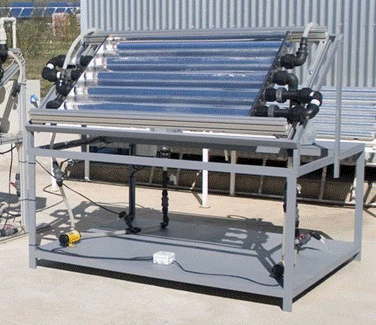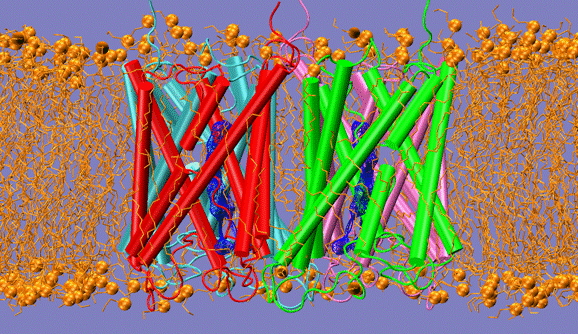Air and Water Purification
PICADA![]() (Photocatalytic Innovative Coverings Applications for De-pollution Assessment) is a project to investigate the use of titanium dioxide nanoparticles for architectural coatings with de-soiling and de-polluting properties. Titanium dioxide is a potent oxidising agent that, when exposed to sunlight, acts as a catalyst to break down volatile organic compounds, nitrogen oxide and other pollutants into less harmful species. Ultraviolet radiation generates electron-hole pairs that react with oxygen and water molecules to form free radicals that decompose compounds on the surface. A reduction in nitrogen oxide levels of up to 80% has been observed for paints and cements containing titanium dioxide nanoparticles tested in the Indoortron environmental chamber at the Joint Research Centre. For outdoor tests in simulated street canyons the nitrogen oxide concentrations in the air were reduced by 40% to 80% depending on factors such as the emission sources, wind direction and orientation of the coated walls.
(Photocatalytic Innovative Coverings Applications for De-pollution Assessment) is a project to investigate the use of titanium dioxide nanoparticles for architectural coatings with de-soiling and de-polluting properties. Titanium dioxide is a potent oxidising agent that, when exposed to sunlight, acts as a catalyst to break down volatile organic compounds, nitrogen oxide and other pollutants into less harmful species. Ultraviolet radiation generates electron-hole pairs that react with oxygen and water molecules to form free radicals that decompose compounds on the surface. A reduction in nitrogen oxide levels of up to 80% has been observed for paints and cements containing titanium dioxide nanoparticles tested in the Indoortron environmental chamber at the Joint Research Centre. For outdoor tests in simulated street canyons the nitrogen oxide concentrations in the air were reduced by 40% to 80% depending on factors such as the emission sources, wind direction and orientation of the coated walls.

Testing the performance of photocatalytic coatings in the Indoortron facility.
(J. Barrero-Moreno, Joint Research Centre Ispra)
SODIS![]() (Solar Disinfection of Water) is developing methods for providing clean drinking water in developing countries or in emergency situations, where water borne diseases constitute a severe threat. Photocatalytic disinfection of water containing pathogenic microorganisms is effective also for chlorine resistant organisms. Tests have shown significantly increased disinfection efficiencies using photocatalysis compared to ultraviolet irradiation alone. Photocatalysis on both a laboratory and pilot scale has been shown to be an effective method for the treatment of water containing pollutants and micro-organisms. Solar photocatalysis will be the main future technology breakthrough for water treatment and purification, especially in developing regions. Further research is needed however to discover how to control the process to eliminate toxic by-products. The possible health risks of using nanoparticles for water purification need also to be investigated.
(Solar Disinfection of Water) is developing methods for providing clean drinking water in developing countries or in emergency situations, where water borne diseases constitute a severe threat. Photocatalytic disinfection of water containing pathogenic microorganisms is effective also for chlorine resistant organisms. Tests have shown significantly increased disinfection efficiencies using photocatalysis compared to ultraviolet irradiation alone. Photocatalysis on both a laboratory and pilot scale has been shown to be an effective method for the treatment of water containing pollutants and micro-organisms. Solar photocatalysis will be the main future technology breakthrough for water treatment and purification, especially in developing regions. Further research is needed however to discover how to control the process to eliminate toxic by-products. The possible health risks of using nanoparticles for water purification need also to be investigated.

Flow-through compound parabolic collector (CPC) solar photocatalytic reactor.
(P. Fernández Ibáñez, Plataforma Solar de Almería)
EJIPAC![]() (The European-Japanese Initiative on Photocatalytic Applications and Commercialisation) aims to establish collaboration between Japanese and European companies and institutions in the field of self cleaning surface coatings and air and water purification methods. Its main objective is to make photocatalytic technologies available to European industries and users, especially in the areas of self-cleaning surfaces, anti-microbial surfaces, anti-fogging, hydrophilic and architectural coatings, water treatment and air purification. Additional aims are to encourage technological development and to make technologies available to small and medium-size enterprises in order to convert the results of basic research into marketable products. In contrast to Japan, where a number of companies are already marketing technologies for self cleaning or germicidal surfaces, attention in Europe has been mainly concentrated on water treatment methods.
(The European-Japanese Initiative on Photocatalytic Applications and Commercialisation) aims to establish collaboration between Japanese and European companies and institutions in the field of self cleaning surface coatings and air and water purification methods. Its main objective is to make photocatalytic technologies available to European industries and users, especially in the areas of self-cleaning surfaces, anti-microbial surfaces, anti-fogging, hydrophilic and architectural coatings, water treatment and air purification. Additional aims are to encourage technological development and to make technologies available to small and medium-size enterprises in order to convert the results of basic research into marketable products. In contrast to Japan, where a number of companies are already marketing technologies for self cleaning or germicidal surfaces, attention in Europe has been mainly concentrated on water treatment methods.
MEMBAQ![]() (Incorporation of Aquaporins in Membranes for Industrial Applications) is a research project to develop biotechnological membranes for the production of ultra pure water. Aquaporins are natural protein channels that transport water through cell membrane. They have unique selectivity and transport only pure water molecules by forming narrow pores in the cell membrane that prevent salt and other ions from passing but allow water molecules to flow. This leads to an extremely high water permeation rate, depending on the hydrostatic or osmotic pressure, and theoretically up to fifty times increased efficiency compared with conventional industrial membranes. The ultimate aim is to develop an entirely new type of water filtration technology by incorporating aquaporin molecules into industrial membranes. Three different applications are being investigated: water purification, ocean energy generation using the salinity gradient and industrial wastewater reclamation and reuse.
(Incorporation of Aquaporins in Membranes for Industrial Applications) is a research project to develop biotechnological membranes for the production of ultra pure water. Aquaporins are natural protein channels that transport water through cell membrane. They have unique selectivity and transport only pure water molecules by forming narrow pores in the cell membrane that prevent salt and other ions from passing but allow water molecules to flow. This leads to an extremely high water permeation rate, depending on the hydrostatic or osmotic pressure, and theoretically up to fifty times increased efficiency compared with conventional industrial membranes. The ultimate aim is to develop an entirely new type of water filtration technology by incorporating aquaporin molecules into industrial membranes. Three different applications are being investigated: water purification, ocean energy generation using the salinity gradient and industrial wastewater reclamation and reuse.

Aquaporin water channel embedded in a lipid bilayer acts as a highly selective filter.
(H. Khandelia, University of Southern Denmark)